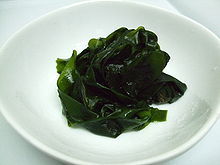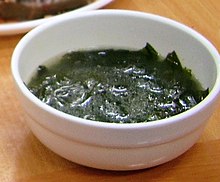| Wakame | |
|---|---|
 | |
| Scientific classification | |
| Kingdom: | Chromalveolata |
| Division: | Heterokontophyta |
| Class: | Phaeophyceae |
| Order: | Laminariales |
| Family: | Alariaceae |
| Genus: | Undaria |
| Species: | U. pinnatifida |
| Binomial name | |
| Undaria pinnatifida (Harvey) Suringar, 1873 | |
Sea-farmers have grown wakame for hundreds of years in Japan and Korea and it has been nominated as among 100 of the world's worst invasive species according to the Global Invasive Species Database.[1]
Contents
|
History in the West
In 1867 the word "wakame" first appeared in an English-language publication, A Japanese and English Dictionary, by James C. Hepburn.[citation needed]Starting in the 1960s, the word "wakame" started to be used widely in the United States, and the product (imported in dried form from Japan) became widely available at natural food stores and Asian-American grocery stores, due to the influence of the macrobiotic movement, and in the 1970s with the growing number of Japanese restaurants and sushi bars.
Health
New studies conducted at Hokkaido University have found that a compound in wakame known as fucoxanthin can help burn fatty tissue.[2] Studies in mice have shown that fucoxanthin induces expression of the fat-burning protein UCP1 that accumulates in fat tissue around the internal organs. Expression of UCP1 protein was significantly increased in mice fed fucoxanthin. Wakame is also used in topical beauty treatments. See also Fucoidan.In Oriental medicine it has been used for blood purification, intestinal strength, skin, hair, reproductive organs and menstrual regularity.[3]
Aquaculture
Japanese and Korean sea-farmers have grown wakame for centuries and they still are the main producers and eaters.[citation needed] Since 1983 wakame is also cultivated in France, in sea fields established near the shores of Brittany.[4]Wild grown wakame is harvested in Tasmania, Australia, and then sold in restaurants in Sydney.[5]
As food
Wakame fronds are green and have a subtly sweet flavour and slippery texture. The leaves should be cut into small pieces as they will expand during cooking.In Japan and Europe, wakame is distributed either dried or salted, and used in soups (particularly miso soup), and salads (tofu salad), or often simply as a side dish to tofu and a salad vegetable like cucumber. These dishes are typically dressed with soya sauce and vinegar/rice vinegar.
- In China, it is called qundaicai (裙带菜).[6] Chinese production is concentrated around Dalian.
- In Korea, it is called miyeok (미역)[6] and used in salads or soup such miyeokguk.
- In French, it is called "fougère des mers".
- In English, it can be called "sea mustard".
Invasive species
Native to cold temperate coastal areas of Japan, Korea and China, in recent decades it has become established in New Zealand, the United States, France, Great Britain, Spain, Italy, Argentina and Australia.[8] It was nominated one of the 100 worst invasive species in the world.[1]New Zealand
In New Zealand, wakame is a very serious weed. It was first discovered in Wellington Harbour in 1987. It probably arrived accidentally in the late 1980s, via shipping from Asia, in ballast water.Wakame is now found around much of south-eastern New Zealand, and as far north as Auckland. It spreads in two ways: naturally, through the millions of microscopic spores released by each fertile organism, and through attachment to vessel hulls and marine farming equipment. It is a highly successful and fertile species, which makes it a serious invader. However, its impacts are not well understood and are likely to vary, depending on the location.




No comments:
Post a Comment